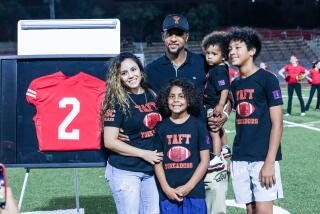ANALYSIS : Latinos Wait in Vain for Recruiters to Come Calling
- Share via
White men can’t jump.
Black men are all natural athletes.
What about Latinos?
Whoever created these absurd basketball stereotypes seems to have overlooked someone: the area’s Latino basketball players go unrecognized by Division I college programs come scholarship time.
Some coaches agree that there’s a reluctance on the part of many college recruiters to take a chance on Latino players, who don’t get the kind of exposure while in high school needed to attract the interest of Division I programs in the first place.
“Basketball is a sport dominated by non-Latino athletes and therefore, if a player is not black or white, many may say he is not athletic,” said Los Angeles City College basketball Coach Mike Miller. “Coaches and people in the media are also a little guilty of stereotyping.”
Of the 16 players named to the All-City Section 4-A Division Team this year, 10 were from the Central City area. Six-foot-one Joe Covarrubias of Huntington Park was the only Latino on the team.
Seven representatives from the Central City area were named to the 3-A team. Four--Jerry Espinoza of Bell, Gerardo Roman of Lincoln and Roosevelt’s Mario Hernandez and Paul Burgueno--are Latino.
Covarrubias averaged 20 points and six assists last season. Roman averaged 27 points and Espinoza, 20. None of them received scholarship offers from a Division I school.
Alex Gomez found himself in the same predicament last year.
Gomez, who averaged 26 points and nine rebounds for Garfield High, was the only Latino named to the 1993 City Times All-Star Team. Gomez, 6-5, led the area in scoring but was not offered a scholarship from a Division I school.
Gomez made the UC Irvine team as a walk-on but quit three weeks later.
“Walk-ons don’t receive scholarships,” Gomez said. “I had to quit because I needed a job.
Gomez said he would like to try again next year as a walk-on, but remains uncertain. “The school is raising its fees and I probably won’t be able to afford it,” he said.
LACC’s Miller is familiar with the prejudice Latino basketball players encounter. “Many (Latino players) need a coach who will give them a chance and care about them,” he said.
Miller coached at Cathedral High School from 1987-89 and amassed a 43-11 record with an all-Latino team. The Phantoms won two consecutive Santa Fe League Championships and went to the Southern SectionFinal Four both years.
Miller’s top player at Cathedral was Luis Fuentes, who earned All-Southern Section honors and was voted Most Valuable Player of the Santa Fe League in 1989. Fuentes, who was not offered a Division I scholarship, went to Glendale College where he played little, became discouraged and gave up.
Said Miller: “Those were some of the most dedicated kids I have ever coached. Many of these players are victimized by the system.”
Bell High Coach Randy Kiehm offered another perspective. “At many of the Southeastern Conference schools there are kids 6-2, playing in the post that don’t get the exposure of handling the ball,” he said. “A 6-2 post player is not going to make it at the next level.”
USC basketball Coach George Raveling said coaches are responsible for getting their players adequate exposure.
“High school coaches have an obligation to sell their kids,” he said. “Maybe the kids (in that area) being overlooked are not getting out to the summer camps and summer leagues where they can be seen. Ethnic background doesn’t make a difference. If a guy can play, I don’t think anyone cares what nationality he is.”
Raveling, who guided the Trojans to a birth in the National Invitation Tournament last season, added: “College coaches are always accused of only being interested in winning. If that’s true, wouldn’t coaches be there looking at these kids? If a coach called me and told me that they had a kid that I should see, either I or one of my assistants would be there.”
More to Read
Get our high school sports newsletter
Prep Rally is devoted to the SoCal high school sports experience, bringing you scores, stories and a behind-the-scenes look at what makes prep sports so popular.
You may occasionally receive promotional content from the Los Angeles Times.






